
Your lungs work hard every minute you’re on the job. Dust, fume, mist, vapour, and gas can damage them if you don’t control exposure. Small changes at work can prevent big health problems later. You can start today with simple steps and clear habits. Let’s begin by spotting the main hazards you might face.
What Are The Main Things At Work That Harm the Lungs?
Airborne dust, mist, fume, vapour, gas, and spores are the usual culprits. Silica dust, welding fume, isocyanates, wood dust, flour dust, and diesel exhaust are common across many trades. Cleaning and maintenance can also stir up mould or chemical vapours. Tasks like cutting, sanding, spraying, and mixing release the most into the air. Once you know the hazards, you can use the right order of controls to reduce them.
How Do I Reduce Risk Using The Hierarchy Of Control?
Start by removing the risky task altogether, if you can. If not, switch to a safer product or method that creates less dust or fume. Enclose the process or keep people away from it to cut exposure. Add engineering controls, such as extraction, before you rely on masks. With that order in mind, you can judge when local exhaust ventilation is needed and if it actually works.
Do I Need Local Exhaust Ventilation (LEV), And How Do I Know It’s Working?
Use LEV when a process makes dust or fume that you can’t fully enclose. Good LEV captures the cloud at the source, not at your face. Simple smoke or tissue tests show if hoods are pulling as they should. Clean filters, tight ducting, and regular tests keep performance steady. Once extraction is set, you can cut even more dust by changing how you work at the source.
How Can I Cut Dust And Fume At The Source On Site?
Use wet methods to keep dust from lifting into the air. Fit on-tool extraction to saws, grinders, and sanders. Choose low-fume consumables and keep your distance between cuts. Limit time near the source and clean with an M- or H-class vacuum, not a dry broom. After source control, match the right respirator to the job for extra protection.
Which Respirator Should I Wear For My Job, And What Do The Ratings Mean?
Pick a mask for the specific hazard and task length. FFP3 or P3 filters provide effective protection against fine dusts such as silica and wood dust. Half-face, full-face, or powered air units help when exposure is higher or the job is long. Use gas filters (such as ABEK types) when vapours are present. Once you choose a mask, make sure it fits your face.
What Is Face-Fit Testing, And How Often Should It Be Done?
Face-fit testing checks that a tight-fitting mask seals on your skin. Do it before first use and repeat if you change mask model, change weight, have dental work, or grow facial hair. Perform a quick fit-check every time you put the mask on. People with beards should use loose-fitting powered air instead. A well-fitted mask still needs proper care and timely filter changes to work effectively.
How Do I Store, Clean, And Replace Filters So My Mask Actually Works?
Store masks clean and dry in a sealed box or bag, away from dust and solvents. Wash reusable parts as the maker advises and let them dry fully. Change filters on a schedule or when breathing gets harder or you smell vapours. Never share masks unless you clean them first and check the seal. With RPE in good shape, you should also track your lung health over time.
When Do I Need Health Surveillance Like Spirometry, And What Does It Show?
You need health surveillance when work could still harm lungs even after controls. Spirometry measures how much air you blow out and how fast you blow it. Regular tests can spot early change so you can act sooner. A clinician may suggest tweaks to controls or to your role if results dip. Alongside health checks, air monitoring shows what you actually breathe on the job.
Should I Get Air Monitoring, And What Will The Results Tell Me?
Personal air monitoring samples the air in your breathing zone during real tasks. Results are compared with workplace exposure limits to judge risk. If levels are high, you must improve controls and check them again. Keep reports with your risk assessments and training records. With the numbers clear, you can apply extra task-specific steps where they matter most.
What Extra Steps Help For Specific Tasks Like Welding, Spraying, Or Flour Handling?
Welding needs tip-extraction or hood capture, clean airflow, and the right consumables. Spraying needs good booth airflow, isocyanate controls, and proper cure times. Bakeries should control flour dust during tipping, dosing, and cleaning with closed systems and vacuums. Woodworking needs well-set extraction at each machine and tidy housekeeping. Once task rules are set, plan how small teams and contractors will follow them day to day.
How Do I Plan Lung Safety For Small Teams, Contractors, And The Self-Employed?
Write a short COSHH risk assessment for each dusty job. Show the controls during inductions and point to the kit on site. Check that contractors follow the same rules and bring tested equipment. Keep a list of who needs masks, fit tests, and health checks. With people aligned, focus training on a few actions that drive real behaviour change.
What Training And Toolbox Talks Make A Real Difference?
Keep talks short and focused on one task or control. Show how to use LEV and how to check if it is pulling at the source. Demonstrate a daily mask fit-check and a quick filter change. Share one recent near miss and what you fixed. After skills are in place, help your team with habits that support lung health.
How Do Smoking, Vaping, And Lifestyle Affect Lung Risk At Work?
Smoking adds to the harm from dust and fumes and slows recovery. Vaping can irritate airways for some people, especially in dusty areas. Offer support to cut down or stop, and signpost to local services. Sleep, nutrition, and fitness help the body cope with exposure. Keep those habits steady, and keep good records to prove your controls work.
What Records Should I Keep To Prove Controls And Track Health?
Keep LEV test reports, maintenance logs, and filter-change dates. Record mask issue, face-fit results, and storage locations. File the air monitoring data, along with the fixes you made, after any high result. Store training and toolbox talk dates so refreshers are easy to plan. With records in order, you can act fast after an incident or near miss.
What Should I Do After An Exposure Incident Or A Near Miss?
Stop the job and make the area safe at once. Report the event, record what happened, and capture photos if allowed. Seek medical advice if you have symptoms or worries. Investigate the root cause with the team and update controls. Then choose equipment and suppliers that make those updates stick.
How Do I Choose Reliable Equipment And Suppliers Without Overspending?
Look for products that meet recognised standards and have clear manuals. Ask for trials or demos so staff can test the gear on real tasks. Check that spares and filters are readily available and priced fairly. Compare service plans and total life cost, not just the first price. For those managing workplace safety, understanding what to expect at an asbestos medical can also help align equipment choices with proper health monitoring standards. With the right kit on order, set a short plan to improve lung safety in the next 90 days.
What Does A Simple 90-Day Plan Look Like To Improve Lung Safety?
Weeks 1–2: list dusty tasks, walk the site, and fix obvious leaks or broken hoods. Weeks 3–4: test LEV, order spares, and set cleaning and filter routines. Weeks 5–6: face-fit test staff, issue masks, and label storage and change dates. Weeks 7–10: run short toolbox talks and tidy work areas to support the new habits. Weeks 11–12: review air data, health checks, and logs, then set the next quarter’s targets.
Protect Your Lungs At Work
Control hazards at the source before you reach for a mask. Keep the extraction working and check it often with simple tests. Please choose the right respirator, fit-test it, and look after it well. Track results, fix gaps, and refresh training so good habits stick. Use this plan to protect your lungs today and in the months ahead. For workplaces handling hazardous materials, expert asbestos testing and medical services can further safeguard long-term health and compliance.
